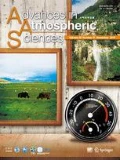Abstract
On the basis of a three year record of Radiosonde observations over Indian region, the autocorrelation function and structure function of the humidity mixing ratio (r) were computed for 850 hPa level. These are necessary for the construction of a suitable objective analysis scheme for humidity over Indian region using optimum interpolation method. The statistics were derived for the monsoon period (June through September) for 850 hPa level.
In order to model the humidity correlation for Indian region, two types of curves were fitted: (i) μ(ρ)=a exp (-bρ), (ii) μ(ρ)=A exp (-Bρ2) where μ is the autocorrelation function — a function of distance ρ-between two observing stations. It was found that the best description of humidity correlation function was given by Eq. (1). The value of ‘a’ gives a quantitative impression of the observation error. Further, the mean random errors were computed from structure functions, the weighting factors for the observing stations with respect to each grid point were calculated, and objective analyses were made for the humidity mixing ratio.
Similar content being viewed by others
References
Alaka, M. A. and Elvander, R. C. (1972), Optimum interpolation from observations of mixed quality,Mon. Weath. Rev.,100: 612–624.
Alaka, M. A. and Elvander, R. C. (1972), Matching of observational accuracy and sampling resolution in meteorological data acquisition experiments,J. Appl. Met.,11: 567–577.
Beckman, F. S. (1960), Mathematical Methods for Digital Computers, Vol. 1, A. Ralston and H. S. Wilf, Eds., Wiley, 62–72.
Cressman, G. P. (1959), An operational objective analysis system,Mon. Weath. Rev.,87: 367–374.
Gandin, L. S. (1963), Objective analysis of meteorological fields, Gidrometeorologicheskoe Izdatel’stvo. Leningrad, USSR, 286.
Maanen, J. V. (1981), Objective analysis of humidity by the optimum interpolation method.Tellus,33: 113–122.
Rajamani, S. et al. (1983), Objective analysis of wind field over Indian region by optimum interpolation method,Mausam,34: 43–50.
Author information
Authors and Affiliations
Rights and permissions
About this article
Cite this article
Sinha, S.K., Talwalkar, D.R. & Rajamani, S. On some aspects of objective analysis of humidity over indian region by the optimum interpolation method. Adv. Atmos. Sci. 4, 332–342 (1987). https://doi.org/10.1007/BF02663603
Received:
Issue Date:
DOI: https://doi.org/10.1007/BF02663603




